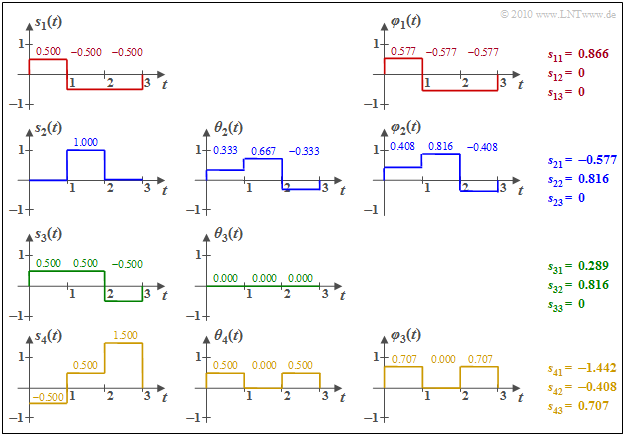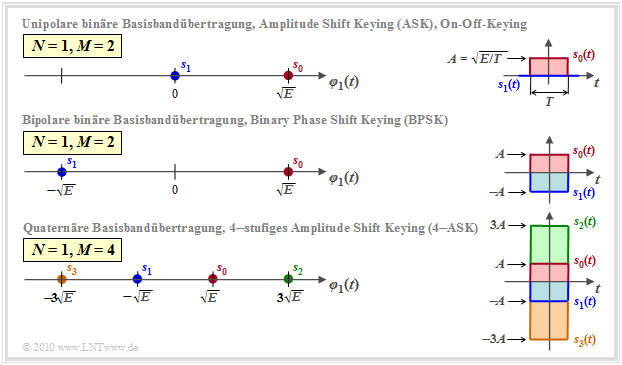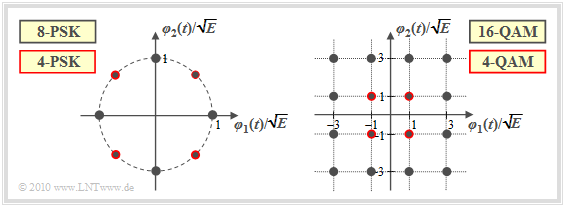Contents
# OVERVIEW OF THE FOURTH MAIN CHAPTER #
The fourth main chapter provides an abstract description of digital signal transmission, which is based on basis functions and signal space constellations. This makes it possible to treat very different configurations - for example band-pass systems and those for the baseband - in a uniform way. The optimal receiver in each case has the same structure in all cases.
The following are dealt with in detail:
- the meaning of basis functions and finding them using the Gram-Schmidt method,
- the structure of the optimal receiver for baseband transmission,
- the theorem of irrelevance and its importance for the derivation of optimal detectors,
- the optimal receiver for the AWGN channel and implementation aspects,
- the system description by complex or $N$–dimensional Gaussian noise,
- the error probability calculation and approximation under otherwise ideal conditions,
- the application of the signal space description to carrier frequency systems,
- the different results for OOK, M-ASK, M-PSK, M-QAM and M-FSK,
- the different results for coherent and non-coherent demodulation.
Almost all results of this chapter have already been derived in previous sections. However, the approach is fundamentally new:
- In the $\rm LNTwww$ book "Modulation Methods" and in the first three chapters of this book, the specific system properties were already taken into account in the derivations – for example, whether the digital signal is transmitted in baseband or whether digital amplitude, frequency or phase modulation is present.
- Here the systems are to be abstracted in such a way that they can be treated uniformly. The optimal receiver in each case has the same structure in all cases, and the error probability can also be specified for non-Gaussian distributed noise.
It should be noted that this rather global approach means that certain system deficiencies can only be recorded very imprecisely, such as
- the influence of a non-optimal receiver filter on the error probability,
- an incorrect threshold (threshold drift), or
- phase jitter (fluctuations in sampling times).
In particular in the presence of intersymbol interference, the procedure should therefore continue in accordance with the third main chapter.
The description is based on the script [KöZ08][1] by Ralf Kötter and Georg Zeitler, which is closely based on the textbook [WJ65][2]. Gerhard Kramer, who has held the chair at the LNT since 2010, treats the same topic with very similar nomenclature in his lecture [Kra17][3].
In order not to make reading unnecessarily difficult for our own students at the TU Munich, we stick to this nomenclature as far as possible, even if it deviates from other $\rm LNTwww$ chapters.
Nomenclature in the fourth chapter
Compared to the other chapters in $\rm LNTwww$, the following nomenclature differences arise here:
- The "message" to be transmitted is an integer value $m \in \{m_i\}$ with $i = 0$, ... , $M-1$, where $M$ specifies the symbol set size. If it simplifies the description, $i = 1$, ... , $M$ is induced.
- The result of the decision process at the receiver is also an integer with the same symbol alphabet as at the transmitter. This result is also referred to as the estimated value:
- $$\hat{m} \in \{m_i \}, \hspace{0.2cm} i = 0, 1, \text{...}\hspace{0.05cm} , M-1\hspace{0.2cm} ({\rm or}\,\,i = 1, 2, \text{...}\hspace{0.05cm}, M) \hspace{0.05cm}.$$
- The "symbol error probability" $\rm Pr(symbol error)$ or $p_{\rm S}$ is usually referred to as follows in this main chapter:
- $${\rm Pr} ({\cal E}) = {\rm Pr} ( \hat{m} \ne m) = 1 - {\rm Pr} ({\cal C}), \hspace{0.4cm}\text{complementary event:}\hspace{0.2cm} {\rm Pr} ({\cal C}) = {\rm Pr} ( \hat{m} = m) \hspace{0.05cm}.$$
- In a "probability density function" (PDF), a distinction is now made between the random variable ⇒ $r$ and the realization ⇒ $\rho$ according to $p_r(\rho)$. $f_r(r)$ was used for a PDF.
- With the notation $p_r(\rho)$, $r$ and $\rho$ Sare scalars. On the other hand, if random variable and realization are vectors (of suitable length), this is expressed in bold type: $p_{ \boldsymbol{ r}}(\boldsymbol{\rho})$ with the vectors $ \boldsymbol{ r}$ and $\boldsymbol{\rho}$.
- In order to avoid confusion with energy values, the threshold value is now called $G$ instead of $E$ and this is mainly referred to as the decision limit in this chapter.
- Based on the two real and energy-limited time functions $x(t)$ and $y(t)$, the "inner product" is:
- $$<\hspace{-0.1cm}x(t), \hspace{0.05cm}y(t) \hspace{-0.1cm}> \hspace{0.15cm}= \int_{-\infty}^{+\infty}x(t) \cdot y(t)\,d \it t \hspace{0.05cm}.$$
- This results in the "Euklidian norm" or "2–norm" (or "norm" for short):
- $$||x(t) || = \sqrt{<\hspace{-0.1cm}x(t), \hspace{0.05cm}x(t) \hspace{-0.1cm}>} \hspace{0.05cm}.$$
Compared to the script $\rm [KöZ08]$[1], the naming differs as follows:
- The probability of the event $E$ is here ${\rm Pr}(E)$ instead of $P(E)$. This nomenclature change was also made because in some equations probabilities and powers appear together.
- Band–pass signals are still marked with the index "BP" and not with a tilde as in [KöZ08][1]. The corresponding low-pass signal is (usually) provided with the index "TP".
Orthonormal basis functions
Wir gehen in diesem Kapitel von einer Menge $\{s_i(t)\}$ möglicher Sendesignale aus, die den möglichen Nachrichten $m_i$ eineindeutig zugeordnet sind. Mit $i = 1$, ... , $M$ gilt:
- $$m \in \{m_i \}, \hspace{0.2cm} s(t) \in \{s_i(t) \}\hspace{-0.1cm}: \hspace{0.3cm} m = m_i \hspace{0.1cm} \Leftrightarrow \hspace{0.1cm} s(t) = s_i(t) \hspace{0.05cm}.$$
Für das Folgende setzen wir weiter voraus, dass die $M$ Signale $s_i(t)$ energiebegrenzt sind, was meist gleichzeitig bedeutet, dass sie nur von endlicher Dauer sind.
$\text{Satz:}$ Eine jede Menge $\{s_1(t), \hspace{0.05cm} \text{...} \hspace{0.05cm} , s_M(t)\}$ energiebegrenzter Signale lässt sich in $N \le M$ orthonormale Basisfunktionen $\varphi_1(t), \hspace{0.05cm} \text{...} \hspace{0.05cm} , \varphi_N(t)$ entwickeln. Es gilt:
- $$s_i(t) = \sum\limits_{j = 1}^{N}s_{ij} \cdot \varphi_j(t) , \hspace{0.3cm}i = 1,\hspace{0.05cm} \text{...}\hspace{0.1cm} , M, \hspace{0.3cm}j = 1,\hspace{0.05cm} \text{...} \hspace{0.1cm}, N \hspace{0.05cm}.$$
Jeweils zwei Basisfunktionen $\varphi_j(t)$ und $\varphi_k(t)$ müssen orthonormal zueinander sein, das heißt, es muss gelten $(\delta_{jk}$ nennt man das Kronecker–Symbol oder das "Kronecker-Delta"$)$:
- $$<\hspace{-0.1cm}\varphi_j(t), \hspace{0.05cm}\varphi_k(t) \hspace{-0.1cm}> = \int_{-\infty}^{+\infty}\varphi_j(t) \cdot \varphi_k(t)\,d \it t = {\rm \delta}_{jk} = \left\{ \begin{array}{c} 1 \\ 0 \end{array} \right.\quad \begin{array}{*{1}c} {\rm falls}\hspace{0.1cm}j = k \\ {\rm falls}\hspace{0.1cm} j \ne k \\ \end{array} \hspace{0.05cm}.$$
Der Parameter $N$ gibt dabei an, wieviele Basisfunktionen $\varphi_j(t)$ benötigt werden, um die $M$ möglichen Sendesignale darzustellen. Mit anderen Worten: $N$ ist die Dimension des Vektorraums, der von den $M$ Signalen aufgespannt wird. Dabei gilt:
- Ist $N = M$, so sind alle Sendesignale zueinander orthogonal. Sie sind nicht notwendigerweise orthonormal, das heißt, die Energien $E_i = <\hspace{-0.1cm}s_i(t), \hspace{0.05cm}s_i(t) \hspace{-0.1cm}>$ können durchaus ungleich Eins sein.
- Der Fall $N < M$ ergibt sich, wenn mindestens ein Signal $s_i(t)$ als Linearkombination von Basisfunktionen $\varphi_j(t)$ dargestellt werden kann, die sich aus anderen Signalen $s_j(t) \ne s_i(t)$ ergeben haben.
$\text{Beispiel 1:}$ Wir betrachten $M = 3$ energiebegrenzte Signale gemäß der Grafik. Man erkennt sofort:
- Die Signale $s_1(t)$ und $s_2(t)$ sind zueinander orthogonal.
- Die Energien sind $E_1 = A^2 \cdot T = E$ und $E_2 = (A/2)^2 \cdot T = E/4$.
- Die Basisfunktionen $\varphi_1(t)$ und $\varphi_2(t)$ sind jeweils formgleich mit $s_1(t)$ bzw. $s_2(t)$ und beide besitzen die Energie Eins:
- $$\varphi_1(t)=\frac{s_1(t)}{\sqrt{E_1} } = \frac{s_1(t)}{\sqrt{A^2 \cdot T} } = \frac{1}{\sqrt{ T} } \cdot \frac{s_1(t)}{A}$$
- $$\hspace{0.5cm}\Rightarrow \hspace{0.1cm}s_1(t) = s_{11} \cdot \varphi_1(t)\hspace{0.05cm},\hspace{0.1cm}s_{11} = \sqrt{E}\hspace{0.05cm},$$
- $$\varphi_2(t) =\frac{s_2(t)}{\sqrt{E_2} } = \frac{s_2(t)}{\sqrt{(A/2)^2 \cdot T} } = \frac{1}{\sqrt{ T} } \cdot \frac{s_2(t)}{A/2}\hspace{0.05cm}$$
- $$\hspace{0.5cm}\Rightarrow \hspace{0.1cm}s_2(t) = s_{21} \cdot \varphi_2(t)\hspace{0.05cm},\hspace{0.1cm}s_{21} = {\sqrt{E} }/{2}\hspace{0.05cm}.$$
- Das Signal $s_3(t)$ kann durch die vorher bestimmten Basisfunktionen $\varphi_1(t)$ und $\varphi_2(t)$ ausgedrückt werden:
- $$s_3(t) =s_{31} \cdot \varphi_1(t) + s_{32} \cdot \varphi_2(t)\hspace{0.05cm},$$
- $$\hspace{0.5cm}\Rightarrow \hspace{0.1cm} s_{31} = {A}/{2} \cdot \sqrt {T}= {\sqrt{E} }/{2}\hspace{0.05cm}, \hspace{0.2cm}s_{32} = - A \cdot \sqrt {T} = -\sqrt{E} \hspace{0.05cm}.$$
Im rechten unteren Bild sind die Signale in einer 2D–Darstellung mit den Basisfunktionen $\varphi_1(t)$ und $\varphi_2(t)$ als Achsen dargestellt, wobei $E = A^2 \cdot T$ gilt und der Zusammenhang zu den anderen Grafiken durch die Farbgebung zu erkennen ist.
Die vektoriellen Repräsentanten der Signale $s_1(t)$, $s_2(t)$ und $s_3(t)$ in diesem zweidimensionellen Vektorraum lassen sich daraus wie folgt ablesen:
- $$\mathbf{s}_1 = (\sqrt{ E}, \hspace{0.1cm}0), $$
- $$\mathbf{s}_2 = (0, \hspace{0.1cm}\sqrt{ E}/2), $$
- $$\mathbf{s}_3 = (\sqrt{ E}/2,\hspace{0.1cm}-\sqrt{ E} ) \hspace{0.05cm}.$$
Das Verfahren nach Gram-Schmidt
Im $\text{Beispiel 1}$ auf der letzten Seite war die Angabe der beiden orthonormalen Basisfunktionen $\varphi_1(t)$ und $\varphi_2(t)$ sehr einfach, da diese formgleich mit $s_1(t)$ bzw. $s_2(t)$ waren. Das Gram–Schmidt–Verfahren findet die Basisfunktionen $\varphi_1(t)$, ... , $\varphi_N(t)$ für beliebig vorgebbare Signale $s_1(t)$, ... , $s_M(t)$, und zwar wie folgt:
- Die erste Basisfunktion $\varphi_1(t)$ ist stets formgleich mit $s_1(t)$. Es gilt:
- $$\varphi_1(t) = \frac{s_1(t)}{\sqrt{E_1}} = \frac{s_1(t)}{|| s_1(t)||} \hspace{0.3cm}\Rightarrow \hspace{0.3cm} || \varphi_1(t) || = 1, \hspace{0.2cm}s_{11} =|| s_1(t)||,\hspace{0.2cm}s_{1j} = 0 \hspace{0.2cm}{\rm f{\rm \ddot{u}r }}\hspace{0.2cm} j \ge 2 \hspace{0.05cm}.$$
- Es wird nun angenommen, dass aus den Signalen $s_1(t)$, ... , $s_{k-1}(t)$ bereits die Basisfunktionen $\varphi_1(t)$, ... , $\varphi_{n-1}(t)$ berechnet wurden $(n \le k)$. Dann berechnen wir mittels $s_k(t)$ die Hilfsfunktion
- $$\theta_k(t) = s_k(t) - \sum\limits_{j = 1}^{n-1}s_{kj} \cdot \varphi_j(t) \hspace{0.4cm}{\rm mit}\hspace{0.4cm} s_{kj} = \hspace{0.1cm} < \hspace{-0.1cm} s_k(t), \hspace{0.05cm}\varphi_j(t) \hspace{-0.1cm} >, \hspace{0.2cm} j = 1, \hspace{0.05cm} \text{...}\hspace{0.05cm}, n-1\hspace{0.05cm}.$$
- Ist $\theta_k(t) \equiv 0$ ⇒ $||\theta_k(t)|| = 0$, so liefert $s_k(t)$ keine neue Basisfunktion. Vielmehr lässt sich dann $s_k(t)$ durch die $n-1$ bereits vorher gefundenen Basisfunktionen $\varphi_1(t)$, ... , $\varphi_{n-1}(t)$ ausdrücken:
- $$s_k(t) = \sum\limits_{j = 1}^{n-1}s_{kj}\cdot \varphi_j(t) \hspace{0.05cm}.$$
- Eine neue Basisfunktion (nämlich die $n$–te) ergibt sich, falls $||\theta_k(t)|| \ne 0$ ist:
- $$\varphi_n(t) = \frac{\theta_k(t)}{|| \theta_k(t)||} \hspace{0.3cm}\Rightarrow \hspace{0.3cm} || \varphi_n(t) || = 1\hspace{0.05cm}.$$
Diese Prozedur wird fortgesetzt, bis alle $M$ Signale berücksichtigt wurden. Danach hat man alle $N \le M$ orthonormalen Basisfunktionen $\varphi_j(t)$ gefunden. Der Sonderfall $N = M$ ergibt sich nur dann, wenn alle $M$ Signale linear voneinander unabhängig sind.
Dieses Verfahren wird nun an einem Beispiel verdeutlicht. Wir verweisen auch auf das interaktive Applet Gram–Schmidt–Verfahren.
$\text{Beispiel 2:}$ Wir betrachten die $M = 4$ energiebegrenzten Signale $s_1(t)$, ... , $s_4(t)$ entsprechend der Grafik. Zur Vereinfachung der Berechnungen ist hier sowohl die Amplitude als auch die Zeit normiert.
Man erkennt aus diesen Skizzen:
- Die Basisfunktion $\varphi_1(t)$ ist formgleich mit $s_1(t)$. Wegen $E_1 = \vert \vert s_1(t) \vert \vert ^3 = 3 \cdot 0.5^2 = 0.75$ ergibt sich $s_{11} = \vert \vert s_1(t) \vert \vert = 0.866$. $\varphi_1(t)$ selbst besitzt abschnittsweise die Werte $\pm 0.5/0.866 = \pm0.577$.
- Zur Berechnung der Hilfsfunktion $\theta_2(t)$ berechnen wir
- $$s_{21} = \hspace{0.1cm} < \hspace{-0.1cm} s_2(t), \hspace{0.05cm}\varphi_1(t) \hspace{-0.1cm} > \hspace{0.1cm} = 0 \cdot (+0.577) + 1 \cdot (-0.577)+ 0 \cdot (-0.577)= -0.577$$
- $$ \Rightarrow \hspace{0.3cm}\theta_2(t) = s_2(t) - s_{21} \cdot \varphi_1(t) = (0.333, 0.667, -0.333) \hspace{0.3cm}\Rightarrow \hspace{0.3cm}\vert \vert \theta_2(t) \vert \vert^2 = (1/3)^2 + (2/3)^2 + (-1/3)^2 = 0.667$$
- $$ \Rightarrow \hspace{0.3cm} s_{22} = \sqrt{0.667} = 0.816,\hspace{0.3cm} \varphi_2(t) = \theta_2(t)/s_{22} = (0.408, 0.816, -0.408)\hspace{0.05cm}. $$
- Die inneren Produkte zwischen $s_1(t)$ mit $\varphi_1(t)$ bzw. $\varphi_2(t)$ liefern folgende Ergebnisse:
- $$s_{31} \hspace{0.1cm} = \hspace{0.1cm} < \hspace{-0.1cm} s_3(t), \hspace{0.07cm}\varphi_1(t) \hspace{-0.1cm} > \hspace{0.1cm} = 0.5 \cdot (+0.577) + 0.5 \cdot (-0.577)- 0.5 \cdot (-0.577)= 0.289$$
- $$s_{32} \hspace{0.1cm} = \hspace{0.1cm} < \hspace{-0.1cm} s_3(t), \hspace{0.07cm}\varphi_2(t) \hspace{-0.1cm} > \hspace{0.1cm} = 0.5 \cdot (+0.408) + 0.5 \cdot (+0.816)- 0.5 \cdot (-0.408)= 0.816$$
- $$\Rightarrow \hspace{0.3cm}\theta_3(t) = s_3(t) - 0.289 \cdot \varphi_1(t)- 0.816 \cdot \varphi_2(t) = 0\hspace{0.05cm}.$$
Das bedeutet: Die grüne Funktion $s_3(t)$ liefert keine neue Basisfunktion $\varphi_3(t)$, im Gegensatz zur Funktion $s_4(t)$. Die numerischen Ergebnisse hierfür können der Grafik entnommen werden.
Basisfunktionen komplexer Zeitsignale
In der Nachrichtentechnik hat man es oft mit komplexen Zeitfunktionen zu tun,
- nicht etwa, weil es komplexe Signale in der Realität gibt, sondern
- weil die Beschreibung eines Bandpass–Signals im äquivalenten Tiefpass–Bereich zu komplexen Signalen führt.
Die Bestimmung der $N \le M$ komplexwertigen Basisfunktionen $\xi_k(t)$ aus den $M$ komplexen Signalen $s_i(t)$ kann ebenfalls mit dem Gram–Schmidt–Verfahren erfolgen, doch ist nun zu berücksichtigen, dass das innere Produkt zweier komplexer Signale $x(t)$ und $y(t)$ wie folgt zu berechnen ist:
- $$< \hspace{-0.1cm}x(t), \hspace{0.1cm}y(t)\hspace{-0.1cm} > \hspace{0.1cm} = \int_{-\infty}^{+\infty}x(t) \cdot y^{\star}(t)\,d \it t \hspace{0.05cm}.$$
Die entsprechenden Gleichungen lauten nun mit $i = 1, \text{..}. , M$ und $k = 1, \text{..}. , N$:
- $$s_i(t) = \sum\limits_{k = 1}^{N}s_{ik} \cdot \xi_k(t),\hspace{0.2cm}s_i(t) \in {\cal C},\hspace{0.2cm}s_{ik} \in {\cal C} ,\hspace{0.2cm}\xi_k(t) \in {\cal C} \hspace{0.05cm},$$
- $$< \hspace{-0.1cm}\xi_k(t),\hspace{0.1cm} \xi_j(t)\hspace{-0.1cm} > \hspace{0.1cm} = \int_{-\infty}^{+\infty}\xi_k(t) \cdot \xi_j^{\star}(t)\,d \it t = {\rm \delta}_{ik} = \left\{ \begin{array}{c} 1 \\ 0 \end{array} \right.\quad \begin{array}{*{1}c}{\rm falls}\hspace{0.15cm} k = j \\ {\rm falls}\hspace{0.15cm} k \ne j \\ \end{array}\hspace{0.05cm}.$$
Natürlich lässt sich jede komplexe Größe auch durch zwei reelle Größen ausdrücken, nämlich durch Realteil und Imaginärteil. Somit erhält man hier folgende Gleichungen:
- $$s_{i}(t) = s_{{\rm I}\hspace{0.02cm}i}(t) + {\rm j} \cdot s_{{\rm Q}\hspace{0.02cm}i}(t), \hspace{0.2cm} s_{{\rm I}\hspace{0.02cm}i}(t) = {\rm Re}\big [s_{i}(t)\big], \hspace{0.2cm} s_{{\rm Q}\hspace{0.02cm}i}(t) = {\rm Im} \big [s_{i}(t)\big ],$$
- $$\xi_{k}(t) = \varphi_k(t) + {\rm j} \cdot \psi_k(t), \hspace{0.2cm} \varphi_k(t) = {\rm Re}\big [\xi_{k}(t)\big ], \hspace{0.2cm} \psi_k(t) = {\rm Im} \big [\xi_{k}(t)\big ],$$
- $$\hspace{0.35cm} s_{ik} = s_{{\rm I}\hspace{0.02cm}ik} + {\rm j} \cdot s_{{\rm Q}\hspace{0.02cm}ik}, \hspace{0.2cm} s_{{\rm I}ik} = {\rm Re} \big [s_{ik}\big ], \hspace{0.2cm} s_{{\rm Q}ik} = {\rm Im} \big [s_{ik}\big ],$$
- $$ \hspace{0.35cm} s_{{\rm I}\hspace{0.02cm}ik} ={\rm Re}\big [\hspace{0.01cm} < \hspace{-0.1cm} s_i(t), \hspace{0.15cm}\varphi_k(t) \hspace{-0.1cm} > \hspace{0.1cm}\big ], \hspace{0.2cm}s_{{\rm Q}\hspace{0.02cm}ik} = {\rm Re}\big [\hspace{0.01cm} < \hspace{-0.1cm} s_i(t), \hspace{0.15cm}{\rm j} \cdot \psi_k(t) \hspace{-0.1cm} > \hspace{0.1cm}\big ] \hspace{0.05cm}. $$
Die Nomenklatur ergibt sich aus der Hauptanwendung für komplexe Basisfunktionen, nämlich der Quadratur–Amplitudenmodulation (QAM).
- Der Index "I" steht für Inphasekomponente und gibt den Realteil an,
- während die Quadraturkomponente (Imaginärteil) mit dem Index "Q" gekennzeichnet ist.
Um Verwechslungen mit der imaginären Einheit zu vermeiden, wurden hier die komplexen Basisfunktionen $\xi_{k}(t)$ mit $k$ induziert und nicht mit $j$.
Dimension der Basisfunktionen
Bei der Basisbandübertragung sind die möglichen Sendesignale (Betrachtung nur einer Symboldauer)
- $$s_i(t) = a_i \cdot g_s(t), \hspace{0.2cm} i = 0, \text{...}\hspace{0.05cm} , M-1,$$
wobei $g_s(t)$ den Sendegrundimpuls angibt und die $a_i$ in den ersten drei Hauptkapiteln als die möglichen Amplitudenkoeffizienten bezeichnet wurden. Anzumerken ist, dass ab sofort für die Laufvariable $i$ die Werte $0$ bis $M-1$ vorausgesetzt werden.
Nach der Beschreibung dieses Kapitels handelt es sich unabhängig von der Stufenzahl $M$ um ein eindimensionales Modulationsverfahren $(N = 1)$, wobei bei der Basisbandübertragung
- die Basisfunktion $\varphi_1(t)$ gleich dem energienormierten Sendegrundimpuls $g_s(t)$ ist:
- $$\varphi_1(t) ={g_s(t)}/{\sqrt{E_{gs}}} \hspace{0.3cm}{\rm mit}\hspace{0.3cm} E_{gs} = \int_{-\infty}^{+\infty}g_s^2(t)\,d \it t \hspace{0.05cm},$$
- die dimensionslosen Amplitudenkoeffizienten $a_i$ in die Signalraumpunkte $s_i$ umzurechnen sind, die die Einheit "Wurzel aus Energie" aufweisen.
Die Grafik zeigt eindimensionale Signalraumkonstellationen $(N=1)$ für die Basisbandübertragung, nämlich
- (a) binär unipolar (oben) ⇒ $M = 2$,
- (b) binär bipolar (Mitte) ⇒ $M = 2$, sowie
- (c) quaternär bipolare (unten) ⇒ $M = 4$.
Die Grafik beschreibt gleichzeitig die eindimensionalen Trägerfrequenzsysteme
- oben: Zweistufiges Amplitude Shift Keying (2–ASK), auch bekannt als "On–Off–Keying ",
- in der Mitte: Binary Phase Shift Keying (BPSK),
- unten: Vierstufiges Amplitude Shift Keying (4–ASK).
Die dargestellten Signale $s_i(t)$ und die Basisfunktion $\varphi_1(t)$ beziehen sich stets auf den äquivalenten Tiefpass–Bereich.
Im Bandpass–Bereich ist $\varphi_1(t)$ eine auf den Zeitbereich $0 \le t \le T$ begrenzte harmonische Schwingung.
Weitere Anmerkungen:
- In der Grafik rechts sind am Beispiel "Rechteckimpuls" die zwei bzw. vier möglichen Sendesignale $s_i(t)$ angegeben.
- Man kann daraus den Zusammenhang zwischen Impulsamplitude $A$ und Signalenergie $E = A^2 \cdot T$ erkennen.
- Die jeweils linken Darstellungen auf der $\varphi_1(t)$–Achse gelten aber unabhängig von der $g_s(t)$–Form, nicht nur für Rechtecke.
Zweidimensionale Modulationsverfahren
Zu den zweidimensionalen Modulationsverfahren $(N = 2)$ gehören
- M–stufiges Phase Shift Keying (M–PSK),
- Quadratur–Amplitudenmodulation (4–QAM, 16–QAM, 64–QAM, ...),
- Binäres (orthogonales) Frequency Shift Keying (2–FSK).
Allgemein ist bei orthogonaler FSK die Anzahl $N$ der Basisfunktionen $\varphi_k(t)$ gleich der Anzahl $M$ möglicher Sendesignale $s_i(t)$. $N=2$ ist deshalb nur für $M=2$ möglich.
Die Grafik zeigt Beispiele von Signalraumkonstellationen für Zweidimensionale Modulationsverfahren:
- Die linke Grafik zeigt die 8–PSK–Konstellation. Beschränkt man sich auf die rot umrandeten Punkte, so liegt eine 4–PSK (Quaternary Phase Shift Keying, QPSK) vor.
- Die rechte Grafik bezieht sich auf die 16–QAM beziehungsweise – wenn man nur die rot umrandeten Signalraumpunkte betrachtet – auf die 4–QAM.
- Ein Vergleich der beiden Bilder zeigt, dass die 4–QAM mit der QPSK bei entsprechender Achsenskalierung identisch ist.
Die Grafiken beschreiben die Modulationsverfahren sowohl im Bandpass– als auch im äquivalenten Tiefpassbereich:
- Bei der Betrachtung als Bandpass–System ist die Basisfunktion $\varphi_1(t)$ cosinusförmig und $\varphi_2(t)$ (minus–)sinusförmig – vergleiche Aufgabe 4.2.
- Dagegen ist nach der Transformation der QAM–Systeme in den äquivalenten Tiefpassbereich $\varphi_1(t)$ gleich dem energienormierten (also mit der Energie "1") Sendegrundimpuls $g_s(t)$, während $\varphi_2(t)={\rm j} \cdot \varphi_1(t)$ zu setzen ist. Näheres hierzu finden Sie in der Aufgabe 4.2Z.
Aufgaben zum Kapitel
Aufgabe 4.1: Zum Gram-Schmidt-Verfahren
Aufgabe 4.1Z: Andere Basisfunktionen
Aufgabe 4.2: AM/PM-Schwingungen
Aufgabe 4.2Z: Achtstufiges Phase Shift Keying
Aufgabe 4.3: Unterschiedliche Frequenzen
Quellenverzeichnis
- ↑ 1.0 1.1 1.2 Kötter, R., Zeitler, G.: Nachrichtentechnik 2. Vorlesungsmanuskript, Lehrstuhl für Nachrichtentechnik, Technische Universität München, 2008.
- ↑ Wozencraft, J. M.; Jacobs, I. M.: Principles of Communication Engineering. New York: John Wiley & Sons, 1965.
- ↑ Kramer, G.: Nachrichtentechnik 2. Vorlesungsmanuskript, Lehrstuhl für Nachrichtentechnik, Technische Universität München, 2017.



